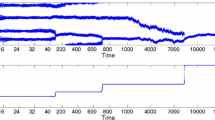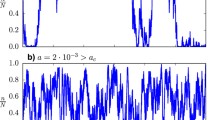Abstract
We study an influence network of voters subjected to correlated disordered external perturbations, and solve the dynamical equations exactly for fully connected networks. The model has a critical phase transition between disordered unimodal and ordered bimodal distribution states, characterized by an increase in the vote-share variability of the equilibrium distributions. The fluctuations (variance and correlations) in the external perturbations are shown to reduce the impact of the external influence by increasing the critical threshold needed for the bimodal distribution of opinions to appear. The external fluctuations also have the surprising effect of driving voters towards biased opinions. Furthermore, the first and second moments of the external perturbations are shown to affect the first and second moments of the vote-share distribution. This is shown analytically in the mean field limit, and confirmed numerically for fully connected networks and other network topologies. Studying the dynamic response of complex systems to disordered external perturbations could help us understand the dynamics of a wide variety of networked systems, from social networks and financial markets to amorphous magnetic spins and population genetics.






Similar content being viewed by others
References
Nowak, A., Latane, B., Szamrej, J.: From private attitude to public opinion: a dynamic theory of social impact. Psychol. Rev. 97(3), 362–376 (1990)
de Oliveira, M.J.: Isotropic majority-vote model on a square lattice. J. Stat. Phys. 66(1–2), 273–281 (1992)
Kirman, A.: Ants, rationality, and recruitment. Q. J. Econ. 108(1), 137–156 (1993)
Krapivsky, P.L., Redner, S.: Dynamics of majority rule in two-state interacting spin systems. Phys. Rev. Lett. 90(23), 238701 (2003)
Galam, S.: Local dynamics vs. social mechanisms: a unifying frame. Europhys. Lett. 70(6), 705–711 (2005)
Miguel, M.S., Eguiluz, V.M., Toral, R., Klemm, K.: Binary and multivariate stochastic models of consensus formation. Comput. Sci. Eng. 7(6), 67–73 (2005)
Chinellato, D.D., de Aguiar, M.A.M., Epstein, I.R., Braha, D., Bar-Yam, Y.: Dynamical response of networks under external perturbations: exact results. arXiv preprint arXiv:0705.4607 (2007)
Castellano, C., Fortunato, S., Loreto, V.: Statistical physics of social dynamics. Rev. Mod. Phys. 81(2), 591 (2009)
da Fontoura Costa, L., Oliveira Jr., O.N., Travieso, G., Rodrigues, F.A., Boas, P.R.V., Antiqueira, L., Viana, M.P., Rocha, L.E.C.: Analyzing and modeling real-world phenomena with complex networks: a survey of applications. Adv. Phys. 60(3), 329–412 (2011)
Galam, S.: Sociophysics: A Physicist’s Modeling of Psycho-Political Phenomena. Springer, Berlin (2012)
Helbing, D., Brockmann, D., Chadefaux, T., Donnay, K., Blanke, U., Woolley-Meza, O., Moussaid, M., Johansson, A., Krause, J., Schutte, S.: Saving human lives: what complexity science and information systems can contribute. J. Stat. Phys. 158(3), 735–781 (2015)
Gonçalves, B., Perra, N.: Social Phenomena: From Data Analysis to Models. Springer, Berlin (2015)
Chinellato, D.D., Epstein, I.R., Braha, D., Bar-Yam, Y., de Aguiar, M.A.M.: Dynamical response of networks under external perturbations: exact results. J. Stat. Phys. 159(2), 221–230 (2015)
Harmon, D., Lagi, M., de Aguiar, M.A.M., Chinellato, D.D., Braha, D., Epstein, I.R., Bar-Yam, Y.: Anticipating economic market crises using measures of collective panic. PLoS ONE 10(7), e0131871 (2015)
Ramos, M., Shao, J., Reis, S.D.S., Anteneodo, C., Andrade, J.S., Havlin, S., Makse, H.A.: How does public opinion become extreme? Sci. Rep. 5, 10032 (2015)
Braha, D., de Aguiar, M.A.M.: Voting contagion: modeling and analysis of a century of US presidential elections. PLoS ONE 12(5), e0177970 (2017)
Liggett, T.M.: Interacting Particle Systems, vol. 276. Springer, Berlin (2012)
Fernández-Gracia, J., Suchecki, K., Ramasco, J.J., Miguel, M.S., Eguíluz, V.M.: Is the voter model a model for voters? Phys. Rev. Lett. 112(15), 158701 (2014)
Latané, B.: The psychology of social impact. Am. Psychol. 36(4), 343 (1981)
Hołyst, J.A., Kacperski, K., Schweitzer, F.: Social impact models of opinion dynamics. In: Annual Reviews Of Computational PhysicsIX, pp. 253–273. World Scientific, Singapore (2001)
Mobilia, M.: Does a single zealot affect an infinite group of voters? Phys. Rev. Lett. 91(2), 028701 (2003)
Galam, S., Jacobs, F.: The role of inflexible minorities in the breaking of democratic opinion dynamics. Phys. A: Stat. Mech. Appl. 381, 366–376 (2007)
Acemoğlu, D., Como, G., Fagnani, F., Ozdaglar, A.: Opinion fluctuations and disagreement in social networks. Math. Oper. Res. 38(1), 1–27 (2013)
Yildiz, E., Ozdaglar, A., Acemoglu, D., Saberi, A., Scaglione, A.: Binary opinion dynamics with stubborn agents. ACM Trans. Econ. Comput. 1(4), 1–30 (2013)
Yaokun, W., Shen, J.: Opinion dynamics with stubborn vertices. Electron. J. Linear Algebra 23(1), 56 (2012)
Galam, S.: Stubbornness as an unfortunate key to win a public debate: an illustration from sociophysics. Mind Soc. 15(1), 117–130 (2016)
Xie, J., Sreenivasan, S., Korniss, G., Zhang, W., Lim, C., Szymanski, B.K.: Social consensus through the influence of committed minorities. Phys. Rev. E 84(1), 011130 (2011)
Xie, J., Emenheiser, J., Kirby, M., Sreenivasan, S., Szymanski, B.K., Korniss, G.: Evolution of opinions on social networks in the presence of competing committed groups. PLoS ONE 7(3), e33215 (2012)
Singh, P., Sreenivasan, S., Szymanski, B.K., Korniss, G.: Accelerating consensus on coevolving networks: the effect of committed individuals. Phys. Rev. E 85(4), 046104 (2012)
Khalil, N., Miguel, M.S., Toral, R.: Zealots in the mean-field noisy voter model. Phys. Rev. E 97(1), 012310 (2018)
Mobilia, M., Petersen, A., Redner, S.: On the role of zealotry in the voter model. J. Stat. Mech. Theory Exp. 2007(08), P08029 (2007)
Galam, S.: Rational group decision making: a random field ising model at t = 0. Phys. A: Stat. Mech. Appl. 238(1–4), 66–80 (1997)
Carletti, T., Fanelli, D., Grolli, S., Guarino, A.: How to make an efficient propaganda. EPL 74(2), 222 (2006)
Kuperman, M., Zanette, D.: Stochastic resonance in a model of opinion formation on small-world networks. Eur. Phys. J. B Condens. Matter Complex Syst. 26(3), 387–391 (2002)
Tessone, C.J., Toral, R.: System size stochastic resonance in a model for opinion formation. Phys. A: Stat. Mech. Appl. 351(1), 106–116 (2005)
González-Avella, J.C., Cosenza, M.G., Tucci, K.: Nonequilibrium transition induced by mass media in a model for social influence. Phys. Rev. E 72(6), 065102 (2005)
Shibanai, Y., Yasuno, S., Ishiguro, I.: Effects of global information feedback on diversity: extensions to axelrod’s adaptive culture model. J. Conflict Resolut. 45(1), 80–96 (2001)
Mazzitello, K.I., Candia, J., Dossetti, V.: Effects of mass media and cultural drift in a model for social influence. Int. J. Mod. Phys. C 18(09), 1475–1482 (2007)
Galam, S.: Heterogeneous beliefs, segregation, and extremism in the making of public opinions. Phys. Rev. E 71(4), 046123 (2005)
Galam, S.: The trump phenomenon: an explanation from sociophysics. Int. J. Mod. Phys. B 31(10), 1742015 (2017)
Galam, S.: Contrarian deterministic effects on opinion dynamics:“the hung elections scenario”. Phys. A: Stat. Mech. Appl. 333, 453–460 (2004)
Shao, J., Havlin, S., Stanley, H.E.: Dynamic opinion model and invasion percolation. Phys. Rev. Lett. 103(1), 018701 (2009)
Li, Q., Braunstein, L.A., Wang, H., Shao, J., Stanley, H.E., Havlin, S.: Non-consensus opinion models on complex networks. J. Stat. Phys. 151(1–2), 92–112 (2013)
Calvão, A.M., Ramos, M., Anteneodo, C.: Role of the plurality rule in multiple choices. J. Stat. Mech.: Theory Exp. 2016(2), 023405 (2016)
Fortunato, S., Castellano, C.: Scaling and universality in proportional elections. Phys. Rev. Lett. 99(13), 138701 (2007)
Palombi, F., Toti, S.: Stochastic dynamics of the multi-state voter model over a network based on interacting cliques and zealot candidates. J. Stat. Phys. 156(2), 336–367 (2014)
de Aguiar, M.A.M., Bar-Yam, Y.: Moran model as a dynamical process on networks and its implications for neutral speciation. Phys. Rev. E 84(3), 031901 (2011)
Watterson, G.A.: Markov chains with absorbing states: a genetic example. Ann. Math. Stat. 32, 716–729 (1961)
Gladstien, K.: The characteristic values and vectors for a class of stochastic matrices arising in genetics. SIAM J. Appl. Math. 34(4), 630–642 (1978)
Cannings, C.: The latent roots of certain markov chains arising in genetics: a new approach, i. haploid models. Adv. Appl. Probab. 6(2), 260–290 (1974)
Lafuerza, L.F., Toral, R.: On the effect of heterogeneity in stochastic interacting-particle systems. Sci. Rep. 3, 1189 (2013)
Schneider, D.M., Martins, A.B., de Aguiar, M.A.M.: The mutation-drift balance in spatially structured populations. J. Theor. Biol. 402, 9–17 (2016)
Limpert, E., Stahel, W.A., Abbt, M.: Log-normal distributions across the sciences: keys and clues: on the charms of statistics, and how mechanical models resembling gambling machines offer a link to a handy way to characterize log-normal distributions, which can provide deeper insight into variability and probability—normal or log-normal: that is the question. AIBS Bull. 51(5), 341–352 (2001)
Yue, S.: The bivariate lognormal distribution to model a multivariate flood episode. Hydrol. Process. 14(14), 2575–2588 (2000)
Kleiber, C., Kotz, S.: Statistical Size Distributions in Economics and Actuarial Sciences, vol. 470. Wiley, New York (2003)
Efron, B., Tibshirani, R.J.: An introduction to the bootstrap. CRC Press, Boca Raton (1994)
Newman, M.E.J., Barkema, G.T.: Monte Carlo Methods in Statistical Physics. Oxford University Press, New York (1999)
Braha, D., de Aguiar, M.A., Ramos, M.: Opinion dynamics on arbitrary networks: scaling theory (in preparation)
Braha, D., Bar-Yam, Y.: From centrality to temporary fame: dynamic centrality in complex networks. Complexity 12(2), 59–63 (2006)
Hill, S.A., Braha, D.: Dynamic model of time-dependent complex networks. Phys. Rev. E 82(4), 046105 (2010)
Braha, D., Bar-Yam, Y.: Time-dependent complex networks: dynamic centrality, dynamic motifs, and cycles of social interactions. In: Gross, T., Sayama, H. (eds.) Adaptive Networks: Theory, Models and Applications, pp. 39–50. Springer, Berlin (2009)
Acknowledgements
The authors thank the referees for their constructive comments and suggestions. MFR is supported by CNPq (Grant \(\#\hbox {152885/2016-1}\)). MAMA was partially supported by Fapesp (Grants \(\#\hbox {2016/05460-3}\) and \(\#\hbox {2016/01343-7}\)) and CNPq.
Author information
Authors and Affiliations
Corresponding author
Appendices
Appendix 1: The Dependence of \(\sigma _{\nu }^2\) on Total Fluctuations
Consider Eq 21. In the fully symmetric case, \((\bar{N_0}=\bar{N_1}\equiv \bar{N}, \sigma _0=\sigma _1\equiv \sigma \) and \(n_0=n_1\equiv n)\). This implies that \(\bar{n}_T=N+\bar{N_0}+\bar{N_1}-1=N+2\bar{N}-1\), and Eq. (21) becomes
In turn, the variance \(\sigma _{\nu }^2\) is given by Eq. (16)
Thus, even without the linear approximation, \(\sigma _{\nu }^2\) is a function of the total fluctuation \(\sigma ^2+\text{ cov }_{01}\).
Appendix 2: Generating the Lognormal Distributions
In this appendix, we describe the methods used to generate the bivariate lognormal distributions for the various simulations.
Consider a semi-symmetric bivariate lognormal distributions (\(\bar{N_0}\ne \bar{N_1}\) and \(\sigma _0^2=\sigma _1^2\equiv \sigma ^2\)) as used in Fig. 3. In this case, we fix the values of \(\bar{N_0}, \bar{N_1}, \sigma \) and \(\rho _{01}\), and determine the values of \(\mu _1\), \(\mu _2\), \(\sigma _{X_1}\), \(\sigma _{X_2}\) and \(\rho \) by solving Eqs. (35) and (36). From these Eqs we can extract the values of \(\sigma _{X_1}\) and \(\mu _1\):
and
The values of \(\sigma _{X_2}\) and \(\mu _2\) can be obtained similarly. The covariance \(\text{ cov }(X_1, X_2)\) is extracted from Eq. (36):
Finally, the expression for \(\rho \) is obtained from \(\rho =\text{ cov }(X_1, X_2)/(\sigma _{X_1}\sigma _{X_2})\). Having determined the values of \(\mu _1\), \(\mu _2\), \(\sigma _{X_1}\), \(\sigma _{X_2}\) and \(\rho \) we can generate a bivariate normal variable \((X_1, X_2)^{T}\), which is then used to generate the external influence vector \(\mathcal {N}=e^{\mathbf {X}}\). The fully symmetric bivariate lognormal distributions as the ones used in Figs. 1, 2 and 4, 5, 6 can be obtained by setting \(\bar{N_0}=\bar{N_1}\equiv \bar{N}\).
Rights and permissions
About this article
Cite this article
Ramos, M., de Aguiar, M.A.M. & Braha, D. Opinion Dynamics on Networks under Correlated Disordered External Perturbations. J Stat Phys 173, 54–76 (2018). https://doi.org/10.1007/s10955-018-2135-5
Received:
Accepted:
Published:
Issue Date:
DOI: https://doi.org/10.1007/s10955-018-2135-5




